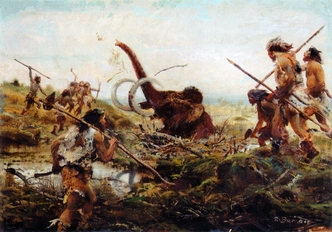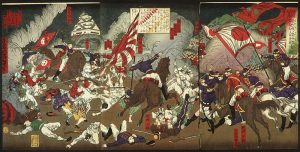Ever wonder how natural instinct aided in our species’ remarkable triumph against the endless dangers of the Paleolithic Age? We should not underestimate the amazing feat of our ancestors’ success in overcoming the scarcity of vital resources and their ability to withstand traumatic encounters with treacherous wildlife. With that in consideration, our predecessors’ ability to analyze, adapt, and overcome obstacles ultimately resulted in the prosperity of our species.
In our most adolescent years of species development, our ancestors established unique methods in conquering the colossal tasks of surviving in the Stone Age. To compensate for their small structure, Paleolithic hominids used simple resources to craft efficient weapons, and applied their intelligence to create impeccable coordinated attacks. Studying the individual and group behavior of their prey enabled our prehistoric hunters to discover new hunting strategies. Through critical thinking, it influenced their decision in choosing the best time to strike their prey so as to ensure positive outcomes from their attacks.1 Their persistence, planning, and effort resulted in the recurrent and inevitable demise of their prey. The types of animals that were chosen in hunts often depended on their size and aggressiveness. In order to continue providing for the hunter-gatherer community, hunters kept wary of the possible risks that came with hunting dangerous animals with dangerous reputations, such as Woolly Mammoths, Woolly Rhinoceros, and Cave Lions. Hunters invented ranged weapons in order to compete with their prey, which changed the necessity of close contact with these large beasts, and really opened up their options in creating more intuitive attacks. This new method of ranged hunting allowed them to attack from safe distances, and ultimately minimized the dangers that came with hunting more rewarding animals.
Hunters were assigned different types of weapons depending on the body type and size of the hunters. This method was established to maximize damage efficiency and control over the advantageous weaponry. Spear throwers were usually tall hunters with proportionally longer arms, which gave them greater leverage and control. Smaller hunters typically used bow and arrows, which did not require long arms, and their training allowed them to master this much more precise and sophisticated approach.2 Attacking in large hunting groups allowed hominins to overwhelm and defeat their much larger prey. Hunting larger animals came with greater risks, but the possible rewards and resources that were obtained through conquering these enormous animals balanced out the possible fatalities: the bigger the risk, the bigger the reward.3

Some of the weapons utilized in these prehistoric encounters were primitive tools made from the simplest materials such as rocks, sticks, and bones. Although wood was much available, bone was preferred when due to its density, strength, and the convenience in being to able to mold it easily. Hominins used animal bones to create spear tips and arrows that would last much longer than the original method of using wooden spear tips.4 Through their inexpensive and useful resources, they were able to create effective hunting tools in small amounts of time, resulting in the discovery of the traditional throwing spear, the bow and arrow, and hunting traps. Their innovative weapons were designed to incapacitate a great variety of animals, and did so with much more efficiency.
Through the astounding accomplishments and efforts of our ancestors, their revolutionary inventions and mental growth has allowed us to thrive in our world, and has helped us develop into the dominant species we are today. Without our ancestors abilities to strategize, coordinate, and desire to survive, our existence would have been wiped off the face of this Earth many million years ago.
- Gerrit Leendert Dusseldorp, “Studying Prehistoric Hunting Proficiency: Applying Optimal Foraging Theory to the Middle Paleolithic and Middle Stone Age,” Quaternary International, 252 (February 2012): 4. ↵
- David W. Frayer, “Body Size, Weapon Use, and Natural Selection in the European Upper Paleolithic and Mesolithic,” American Anthropologist 83, no. 1 (1981): 58. ↵
- Mary C. Stiner, “An Unshakable Middle Paleolithic?,” Current Anthropology 54, no. S8 (2013): 289-290. ↵
- Marina Évora, “Osseous Industry and Exploitation of Animal Resources in Southern Iberia during the Upper Palaeolithic,” Quaternary International, 318 (December 18, 2013): 36-38. ↵



37 comments
Samuel Sanchez
It was an amazing article. It was informative how our ancestors would strategically hunt their prey. It amazes me how each hunter were assigned different weapons. My assumption was that everyone would use the same weapon and just charge in but it’s interesting how they were able to efficiently use all the hunters to their potential. Makes sense on how successful they were to survive for so long.
Sergio Cervantes
An excellent article, I enjoyed reading about the ranged weapons and the materials used to make them. It was interesting to learn that different weapons were assigned to varying body groups and heights. This proves that our ancestors understood the importance of efficiency, especially when it came to hunting animals. It was nice to read of the methods used by our ancestors to survive before adopting plant domestication.
Hayden Hollinger
I found this article very informative and interesting as I found out that survival in the stone age was very strategical, rather than just doing what had to be done to survive, which is what I used to think. The whole process of hunting was planned to every fine detail and this article does a great job of explaining the extent of operations that the people went to.
Tina Valdez
I must have known that life during this time needed to be incredibly strategic for survival purposes, but your article did a great job of painting the picture clearly for me. Hunters being assigned different weapons depending on body size ad choosing which animals to hunt based on size and aggressiveness. Hunters need to be cunning, I had not given this topic as much thought as I did after reading your article. Well done!
Erik Rodriguez
Awesome article! I could not imagine living throughout the Stone Age and having to hunt for a living! It must’ve certainly been a tough life, especially when considering the different obstacles you would have to face. However, it is quite amazing to know how they were able to adapt to their environment and thrive on such harsh conditions.
Very informative and well written article, great job!
Maalik Stansbury
An interesting approach towards this article. I found some psychology in it about the cognition in the human beings early species as to how they think and why they must think that way, including they way they must behave in order to survive. A form of adaption and outwitting was a major factor these early set of species had to do. It was very interesting as to how you wrote and through your explanation a gained a better view as to what happened during this era.
Andres Palacios
Very interesting and well written explanatory article. What got my attention the most was the way they assigned specific weapons depending on the size and skills of the hunters. Creating a very strategic plan in order to hunt animals as big as the mammoth’s.
Diana Moreno-Gutierrez
It is surprising to think that thousands of years ago, the human race was concerned with their survival. They had to have rapid reflexes and be aware of their surrounding which are skills that most of us lack. Now all we have to worry about is picking which restaurant we are going to eat at versus what animal we are going to hunt. I’m sure the weaponry was also of good quality considering they hunted Woolly Mammoths, Woolly Rhinoceros, and Cave Lions. Overall very informative yet interesting article, good job.
Kassandra Guillen
Great and information filled article! It is truly incredible to think of our ancestors going head to head with such dangerous animals like the wooly mammoth and cave lions. It is amazing how they used weapons made of rocks and sticks to hunt. The people of this time certainly deserve recognition for their will to survive and thrive under such incredible conditions.
Jezel Luna
I’ve always wondered how it would be to live in the stone ages and reading this article made me realize that we would have so many people panicking all the time. With these intuitive attacks people would need to be a lot more patient than what we see in society today. Instead of going out and buying food, they would actually have to make the effort to hunt their own prey. It’s heartening to know that because of our ancestors’ hunger to survive we are standing here today. Great job!